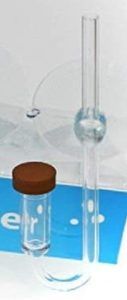Injecting CO2 gas into an aquarium with a diffuser supports plant growth

A CO2 diffuser is a device you push CO2 gas through that breaks the gas into microfine bubbles so the CO2 can more easily dissolve into the water (forming carbonic acid). I use a ceramic/acrylic/glass one from AquaRio and it does a nice job. They bill it as a 2-in-1 diffuser and bubble counter but I’ve never really paid much attention to the bubble counter aspect. The ceramic pad is porous and does a good job of making a lot of highly dispersed microfine bubbles. Having the CO2 bubbles be really small is important: smaller bubbles have a larger ratio of surface area to volume than larger bubbles (the ratio scales as 1.5 / D where D is the diameter of the bubble) which gives the CO2 gas more physical exposure to the water. The smaller bubbles also last longer than larger bubbles: larger bubbles shoot straight up to the water surface and break while the smaller bubbles swirl around in the water for a while before eventually making it to the surface. This additional time also promotes better diffusion of the gas into the water.
Do you really need a CO2 diffuser in an aquarium?
CO2 diffuser mounted under powerhead
I suspect and have done some supportive empirical testing to show that if you have a closed lid tank (as I do) you do not need a diffuser. The rationale is that because CO2 is more dense than air, in a closed lid system the CO2 bubbles whether microfine or not get to the surface and make a blanket of enriched concentration CO2 gas over the entire surface of the water, representing a huge surface area for CO2 diffusion. This won’t work with an open-lid tank since vagaries of air currents in the room, including potentially convection caused by the heat of whatever lighting system you have over the tank, will make the CO2 diffuse into the room much faster than it can diffuse into the water. For a while before the diffuser arrived, I connected up the CO2 source to the main air line bubble system such that instead of bubbling air through the central bubble tube, I was bubbling a CO2/air mixture. The drop checker said this was working. So why not just do that? I feel I have better control over the CO2 with the diffuser, in part because forcing the CO2 through the diffuser makes the diffuser act as a mini-regulator of the CO2 pressure, and in my small tank keeping the CO2 pressure both low and controlled is challenging. That and because it’s fun to watch the CO2 microbubbles swirling around in the current…
CO2 diffuser maintenance
The diffuser works great until it get scunged over with algae whereupon the flow of CO2 gas through the diffuser is greatly reduced or blocked altogether. You can temporarily overcome this by increasing the pressure of the CO2 but this isn’t sustainable and my preference is to properly maintain and clean the diffuser rather than mess with anything upstream.
Easy regular CO2 diffuser maintenance
Lately I have been simply removing the CO2 diffuser system from the tank while still operating, and without dismantling it at all, layering on a couple drops of straight liquid carbon onto the top of the ceramic diffuser disc and letting that fizz away for about 10 minutes. Surprisingly this actually works really well and means you don’t have to take the system apart (which is a hassle) – just reinsert the drop checker system with the liquid carbon still on it back into the water. Try to put the diffuser in a shaded part of the tank, e.g. underneath plants or ideally under a powerhead to distribute the CO2 microbubbles through the flow; having the diffuser out of direct light will inhibit the growth of algae on it so you need to clean it less often.
More vigorous occasional CO2 diffuser maintenance
Removing the diffuser from the tank, disconnecting it from the regular aquarium tubing and instead connecting a syringe with a small piece of disposable tubing will allow you to force straight bleach (sodium hypochlorite solution 1.5 g per 100 g water, also known as ‘thin’ bleach, not ‘thick bleach’) back and forth several times through the ceramic diffuser using the syringe. It might be difficult to force the bleach through at first if the diffuser is really scuzzed over so you can also try soaking the diffuser in bleach for a few minutes first if necessary. Forcing the thin bleach back and forth through the ceramic disc of the diffuser does a wonderful job and returns the diffuser to ‘like new’ condition. There is no need to dilute the thin bleach at all – just be sure to wear protective gloves during the process and thoroughly rinse the diffuser afterwards several times with clean water, forcing the clean water back and forth through the diffuser disc just like you did with the bleach. You want all traces of bleach removed before you connect up the diffuser to the aquarium CO2 line again and reinstall it in the tank. I have also tried 3% hydrogen peroxide instead of thin bleach on the assumption that any potential residual peroxide would be “less dangerous” than bleach, but in my hands the peroxide is not nearly as effective as the bleach is, and I’m not sure the peroxide would actually be any less dangerous anyway. Lots of forced rinses with clean water refreshed several times is key.